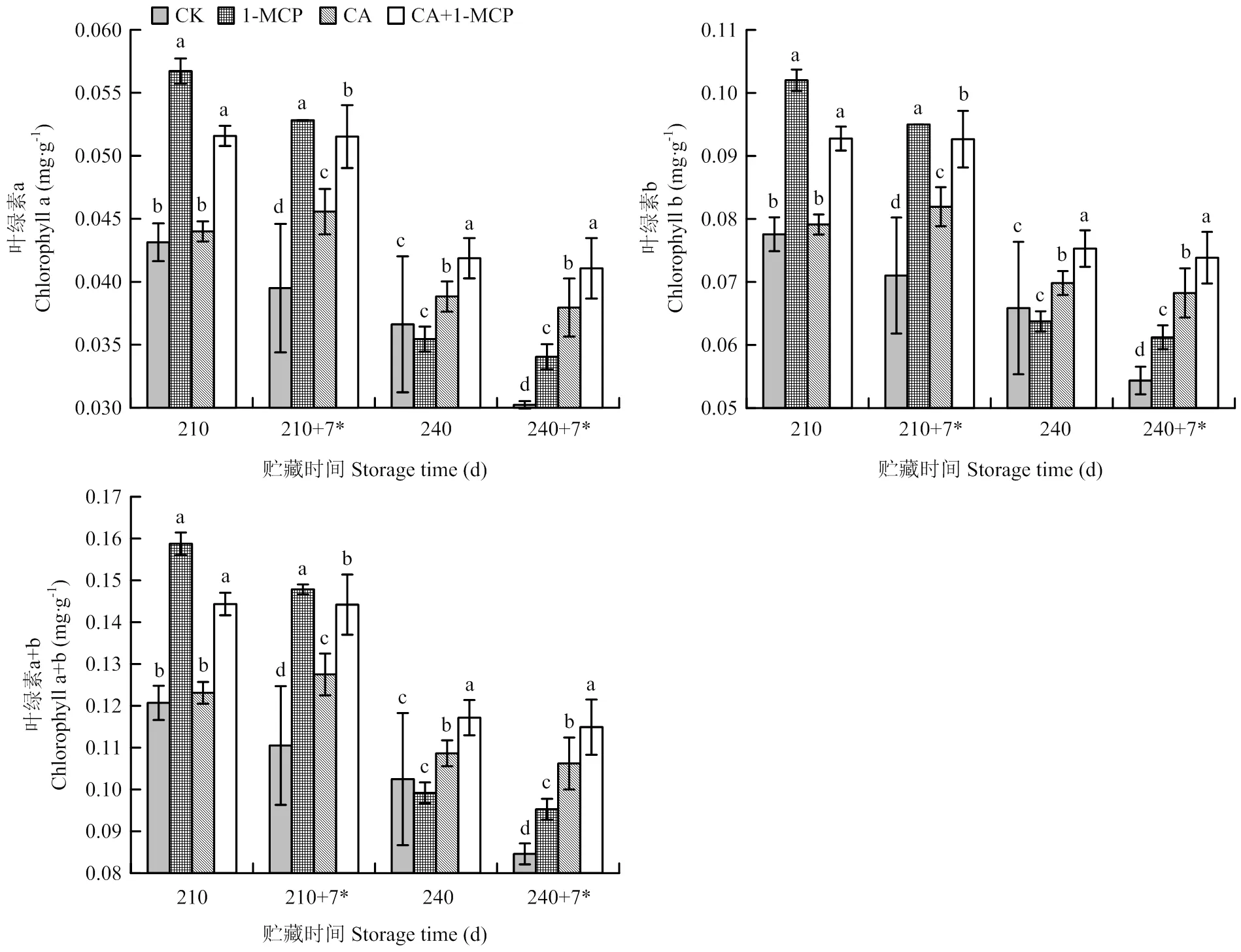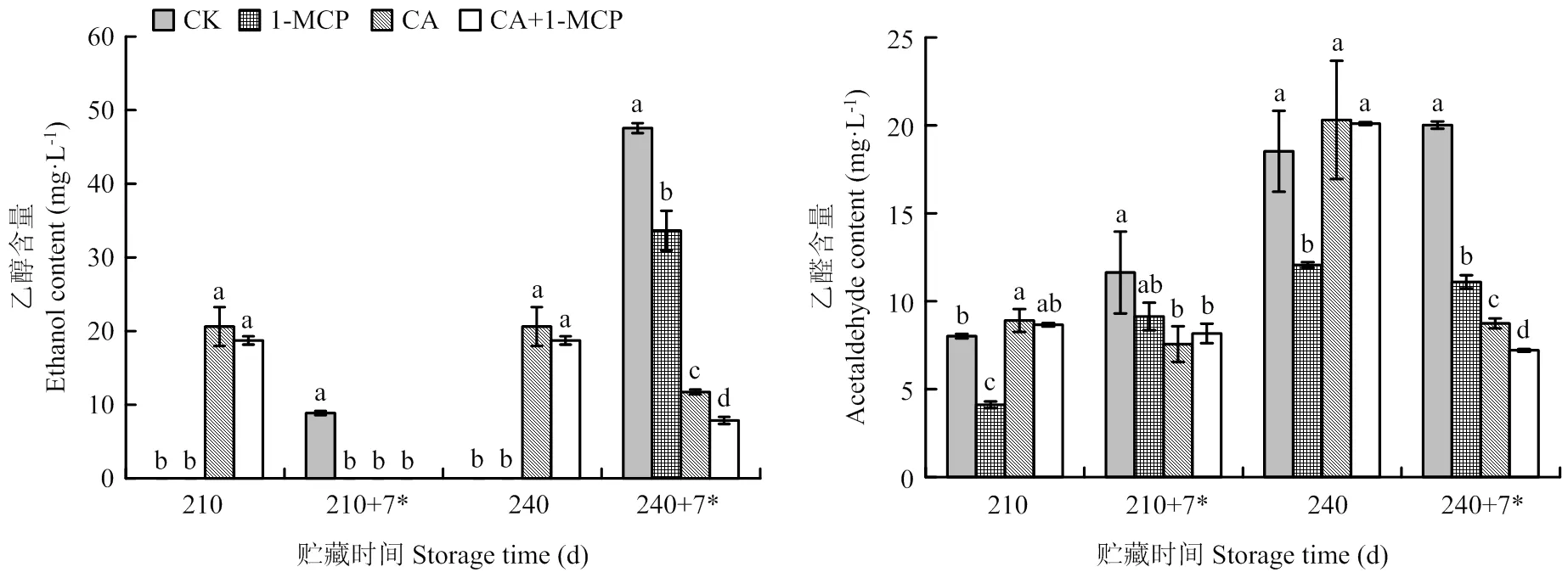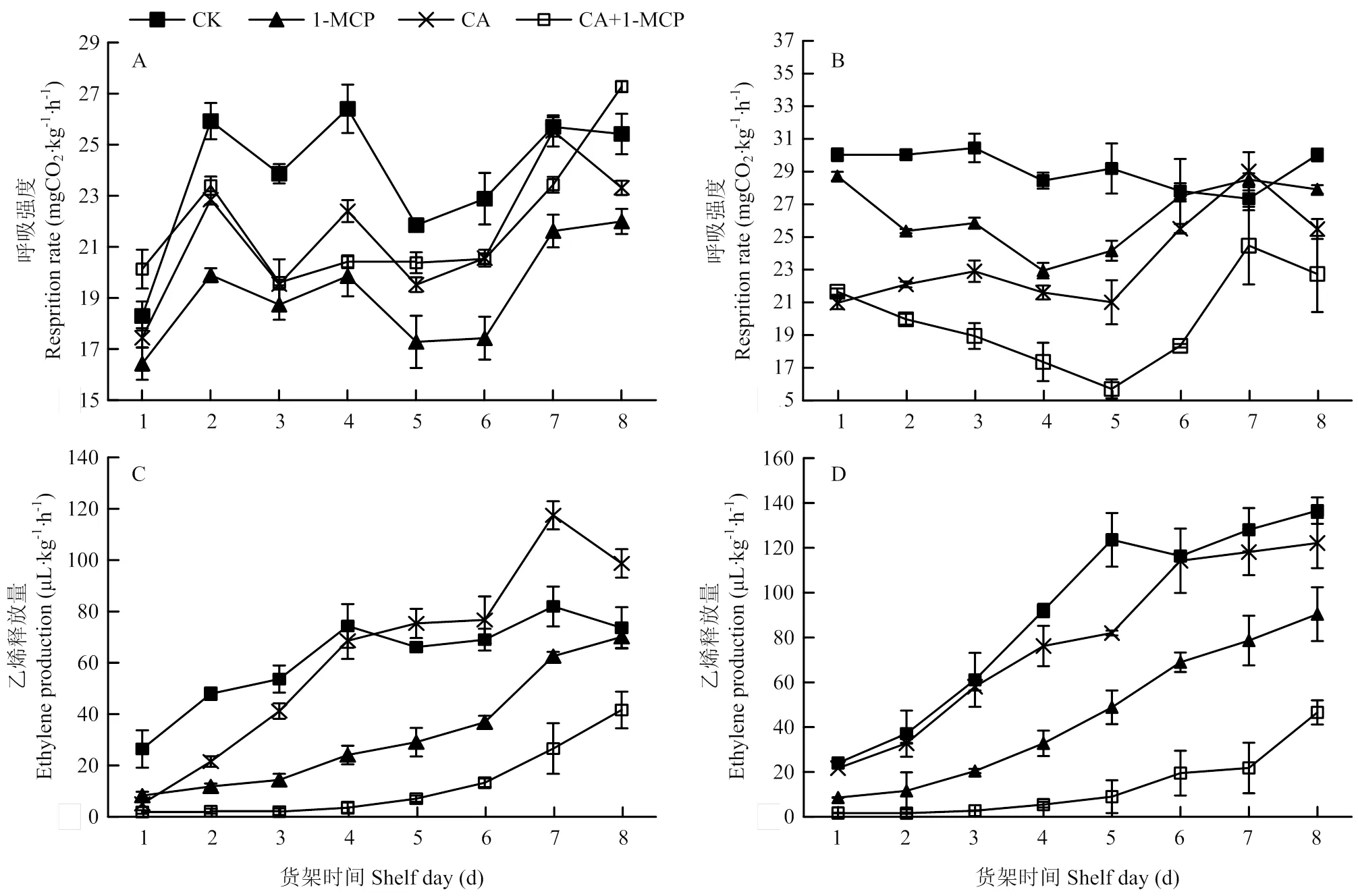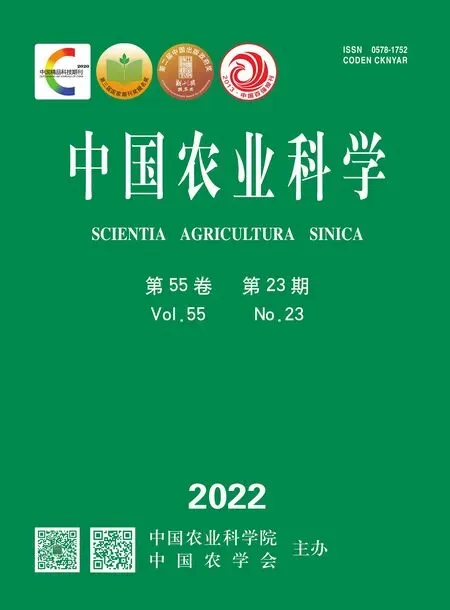低O2/高CO2气调结合1-MCP对‘玉露香’梨贮藏品质的影响
贾晓辉,张鑫楠,刘佰霖,2,马风丽,杜艳民,王文辉
低O2/高CO2气调结合1-MCP对‘玉露香’梨贮藏品质的影响
贾晓辉1,张鑫楠1,刘佰霖1,2,马风丽1,杜艳民1,王文辉1
1中国农业科学院果树研究所/辽宁省果品贮藏与加工重点实验室,辽宁兴城 125100;2德州市农业科学研究院,山东德州 253015
【目的】明确低O2/高CO2对玉露香梨贮藏期保绿效果及品质维持的效果,为生产上延长‘玉露香’梨贮藏寿命提供理论依据与技术支撑。【方法】分别将商业成熟的‘玉露香’梨进行1.0 µL·L-11-甲基环丙烯(1-methylcyclopropene,1-MCP)处理,1% O2、3% CO2气调(controlled atmosphere,CA)贮藏以及1.0 µL·L-11-MCP结合1% O2、3% CO2气调贮藏,以普通冷藏为对照,分别于贮藏210和240 d及货架7 d时,测定果皮颜色、叶绿素含量、果实硬度、可溶性固形物、可滴定酸、抗坏血酸等果实外观和内在品质指标,采用气相色谱法检测果实乙醇、乙醛含量以及乙烯释放量和呼吸强度,调查并计算果柄、果心褐变指数。【结果】与普通冷藏相比,1-MCP、CA以及CA+1-MCP均可使‘玉露香’梨果实外观保持较好的绿色,有效减轻果面油腻化程度,在冷藏240 d及240+7 d货架时,CA+1-MCP对果皮绿色维持及油腻化控制效果更明显。1-MCP和CA均可抑制果实硬度、可溶性固形物和可滴定酸的下降,CA可抑制果心和果柄褐变,但CA降低了果实抗坏血酸含量,CA+1-MCP减缓了CA对果实抗坏血酸的破坏作用。CA+1-MCP对乙醇和乙醛的抑制作用在贮藏240 d时效果更明显,且20 mg·L-1的乙醇含量在‘玉露香’梨耐受阈值以下。CA+1-MCP和1-MCP对果实乙烯释放量具有较好的抑制效果;240 d时,CA+1-MCP和CA对果实呼吸强度的抑制效果好于1-MCP。【结论】‘玉露香’梨较耐低O2和高CO2,CA+1-MCP对‘玉露香’梨的保鲜效果体现在210 d以后。因此,冷藏期在210 d以内,采用1.0 µL·L-1的1-MCP处理;而冷藏期210 d以上,则需1% O2、3% CO2的低O2/高CO2的CA结合1.0 µL·L-1的1-MCP处理,可保持果实较好的外观和内在品质。
低O2/高CO2;1-MCP;‘玉露香’梨;保绿;品质
0 引言
【研究意义】‘玉露香’梨是以库尔勒香梨为母本、‘雪花’梨为父本杂交育成的优质梨新品种[1],具备了‘库尔勒香’梨的汁多、酥脆以及香气浓等特点,深受广大消费者喜爱。目前,在山西、河北、宁夏、山东以及辽宁等地均有种植,产量呈逐年上升趋势,也成为很多地区脱贫致富、乡村振兴的支柱产业。然而,生产实际中发现,‘玉露香’梨贮藏后期果皮退绿转黄且油腻化现象突出,成为限制‘玉露香’梨高质量发展的瓶颈问题[2]。对于绿皮梨而言,退绿转黄是其采后成熟衰老的标志,退绿主要是由叶绿素降解引起[3-4]。如何有效抑制果皮叶绿素降解,延缓褪绿转黄对于保持果实商品性具有重要意义。【前人研究进展】与普通冷藏相比,气调贮藏可有效延长梨果实贮藏寿命[5-7],并已经在西洋梨以及部分白梨品种进行了商业化应用。低O2和/或高CO2气调是在气调基础上进一步降低O2或提高CO2浓度,以达到更长时间维持果实品质的目的。目前,关于西洋梨气调参数研究较多且较系统,如‘Bartlett’[8-9]、‘Packham’s Triumph’[10]、‘d’Anjou’[11-13]、‘Abate Fetel’[14]、‘Rocha’[7,15-16]以及‘Alexander Lucas’[17],且部分品种的气调参数在商业化贮藏中得到广泛应用,相对而言,我国梨品种气调参数研究和商业化应用还较少。已有研究发现,超低氧气调虽可有效延长梨果贮藏寿命,但增加了果心、果肉褐变等生理病害发生的风险[18-19],也会降低果实可滴定酸和维生素C含量,影响果实风味及口感[20],高浓度的CO2则会加重果心褐变[21]。1-甲基环丙烯(1-methylcyclopropene,1-MCP),可以与乙烯竞争结合受体,从而抑制乙烯介导的果实后熟相关生理生化反应[22]。1-MCP可有效抑制果实硬度、可滴定酸和维生素C含量的下降[23-24],抑制货架期果皮退绿转黄速度[25-26],降低虎皮病和黑心病的发生[27-28]。【本研究切入点】前期研究筛选出1% O2和3% CO2的气调贮藏可有效抑制果皮叶绿素的降解,且果实未发生果心、果肉褐变现象,但一定程度上降低了果实可滴定酸和维生素C含量,而1-MCP处理可有效抑制‘玉露香’梨果实常温贮藏条件下可滴定酸和维生素C含量的下降,也起到了较好的保绿效果。基于以上原因,本研究拟通过果实采收后先采用1-MCP熏蒸处理,而后进行气调冷藏。【拟解决的关键问题】探索显著延长‘玉露香’梨果实冷藏期限,既能保持贮藏后期果皮绿色维持,又能抑制果实内在品质的下降。
1 材料与方法
1.1 材料及处理
本研究在2016—2017年‘玉露香’梨气调参数筛选试验基础上开展,从设定的O2分别为1%、3%和5%以及CO2分别为3%和5%的气调参数中,筛选出‘玉露香’梨最佳气调参数为1% O2和3% CO2。在此基础上,2018年9月8日,‘玉露香’梨(Yuluxiang)果实从山西省临汾市隰县午城镇寺坡村采收。果园管理水平中上等,选取10株有代表性的树体,树龄15年。果实采收72 h后运至中国农业科学院果树研究所(辽宁兴城)实验室,挑选大小均匀、成熟度相对一致、无病虫害及机械伤的健康果实,其中20个用于果实基础指标测定(表1)。其余果实作如下处理:
对照组(CK):从挑选出的梨果中取出200个,15℃环境条件下,在塑料帐内密封处理14 h,而后分装入3个气调瓶内,置于(0±0.3)℃下冷藏预冷3 d后,封盖内通空气。
1-MCP组:从挑选出的梨果中取出200个,在15℃环境条件下,用1.0 μL·L-11-MCP在塑料帐密封处理14 h,而后分装入3个气调瓶内,置于(0±0.3)℃下冷藏预冷3 d后,封盖内通空气。
CA组:从挑选出的梨果中取出200个,分装处理同对照组,而后气调瓶连续通1% O2和3% CO2。
CA+1-MCP组:从挑选出的果子中取出200个,分装处理同1-MCP组,而后气调瓶连续通1% O2和3% CO2。
每7 d采用瑞士产Checkmate气体检测仪监测气瓶内气体成分是否稳定,采用排水法检查尾气是否堵塞等。分别于冷藏210和240 d时取出果实,进行相关指标的观察与测定,每次每个处理每个重复随机取出30个果实,其中每个重复中10个果实用于基础值测定,9个果实用于呼吸强度和乙烯释放量测定,10个果实用于7 d货架期测定。

表1 试验用‘玉露香’梨果实基础值
1.2 测定方法
1.2.1 果皮颜色测定 果皮颜色使用CR-400色差仪测定,所用光源为D65光源。具体测定方法见文献[29]。
1.2.2 果实内在品质指标测定 果实硬度用GS-15水果质地分析仪测定,探头直径11.3 mm;可溶性固形物(total soluble solid,TSS)含量用PR-101α折糖仪测定;抗坏血酸(ascorbic acid,ASA)和可滴定酸(titritable acidity,TA)含量使用瑞士万通808智能电位滴定仪测定,具体测定方法见文献[29]。
1.2.3 果皮叶绿素的提取和含量测定 采用紫外分光光度计法,具体参考文献[30]的方法。
1.2.4 乙醇和乙醛含量 采用GC-2010气相色谱仪顶空进样法测定,分别将果肉(包括果皮)和果心匀浆后过滤,取上清液5 mL,在顶空瓶内先后加入1.335—1.350 g NaCl、蒸馏水 1 mL 和上清液5 mL。测定方法参见曹建康等[31]。
1.2.5 果柄褐变指数、果心褐变指数 果柄保鲜指数以果柄干枯长度占果柄总长度的比例计算。共分6级,其中,0级:果柄未干枯;Ⅰ级:果柄干枯长度<1/3;Ⅱ级:果柄干枯长度1/3—1/2;Ⅲ级:果柄干枯长度1/2—2/3;Ⅳ级:果柄干枯长度>2/3;Ⅴ级果柄全部干枯。果心褐变指数以果心褐变面积占果心总面积的比例计算,共分6级,其中,0级:果心无褐变现象,颜色正常;Ⅰ级:果心褐变面积<1/3,即褐变现象较轻微但肉眼能见;Ⅱ级:果心褐变面积1/3—1/2;Ⅲ级:果心褐变面积1/2—2/3;Ⅳ级:果心褐变面积>2/3;Ⅴ级:果心全部褐变。分别根据布朗指数公式进行计算:
果柄褐变指数=×100;
果心褐变指数=×100。
1.2.6 呼吸速率和乙烯释放速率测定 采用SP-7890气相色谱仪(山东鲁南公司)同时进行测定,每天测定1次,连续测定8 d,呼吸强度和乙烯释放量单位分别为mg CO2·kg-1·h-1和μL·kg-1·h-1。具体测定方法参见参考文献[26]。
1.3 数据分析
利用SPSS 22.0软件进行数据统计分析,使用Duncan新复极差法进行不同处理间差异显著性分析。
2 结果
2.1 低O2/高CO2气调结合1-MCP对‘玉露香’梨果皮颜色的影响
L值可较好地反映果皮油腻化程度,其中,L值越高,油腻化程度越高;H值可较好地反映果皮由绿转黄情况,其中,H值越低,果皮越黄。由图1可知,随着贮藏时间的延长,L值逐渐升高,H值逐渐降低。贮藏210 d及210 d+7 d货架时,1-MCP与CA之间L值差异不显著,而在240 d时,CA果实L值均显著低于1-MCP;无论210 d还是240 d,单一的CA或1-MCP处理对H值的影响差异不显著。总体上看,CA、1-MCP以及CA+1-MCP均抑制了果皮L值升高和H值下降,且CA+1-MCP的果皮L值显著低于其他处理,而H值则显著高于其他处理。由此可见,与1-MCP相比,CA可有效抑制冷藏至240 d及后期‘玉露香’梨果皮的油腻化,其中,CA+1-MCP处理的抑制效果明显优于单一的CA或1-MCP处理。肉眼观察发现,与CK相比,不同处理均可使‘玉露香’梨果实外观保持较好的绿色,有效减轻果面油腻化程度,尤其在冷藏240 d及240+7 d货架时,CA+1-MCP对果皮绿色维持及油腻化控制效果更明显(图2),这与果皮颜色测定结果相吻合。

不同小写字母表示相同贮藏时间不同处理间差异显著,*代表货架时间。下同

A: CK; B: 1-MCP; C: CA; D: CA+1-MCP
2.2 低O2/高CO2气调结合1-MCP对‘玉露香’梨果皮叶绿素含量的影响
由图3可知,随着贮藏期的延长,‘玉露香’梨果皮叶绿素含量呈逐渐下降趋势。贮藏210 d及210+ 7 d时,1-MCP组果皮叶绿素a、b及叶绿素a+b含量显著高于CK和CA处理,而贮藏至240 d及货架7 d时,CA以及CA+1-MCP组果皮叶绿素含量显著高于CK和1-MCP组(<0.05)。进一步说明,与1-MCP组相比,CA及CA+1-MCP组可有效抑制‘玉露香’梨贮藏240 d及以后的叶绿素下降,且CA+1-MCP组效果最好。

图3 低O2/高CO2气调结合1-MCP对‘玉露香’梨果皮叶绿素含量的影响
2.3 低O2/高CO2气调结合1-MCP对‘玉露香’梨果柄、果心褐变的影响
贮藏210、210+7 d货架以及240 d时,CA以及CA+1-MCP均未出现果柄褐变现象,240+7 d货架时,果柄出现轻微褐变,但显著低于CK和1-MCP处理;210 d时,CK果心褐变指数显著高于其他3个处理,但3个处理间差异不显著,而210+7 d、240 d以及240+7 d时,不同处理间果心褐变指数差异显著,其中,CA+1-MCP果心褐变指数最低,其次为CA(图4)。因此,CA+1-MCP对果柄、果心褐变的抑制效果最好。

图4 低O2/高CO2气调结合1-MCP对‘玉露香’梨果柄和果心褐变指数的影响
2.4 低O2/高CO2气调结合1-MCP对‘玉露香’梨内在品质的影响
由表2可以看出,整个冷藏期及货架7 d时,与CK相比,1-MCP、CA以及CA+1-MCP均可显著抑制果实硬度的下降(<0.05),但不同处理间差异不显著。210 d及210+7 d货架时,不同处理间可溶性固形物含量差异不显著,而在240 d及240+7 d时,1-MCP、CA以及CA+1-MCP均可显著抑制可溶性固形物的下降(<0.05),且以CA+1-MCP抑制效果最好,其次为CA。整个冷藏期及货架7 d时,与CK相比,1-MCP、CA以及CA+1-MCP均可显著抑制果实可滴定酸含量的下降(<0.05),且以CA+1-MCP抑制效果最好,其次为CA。210 d和240 d时,与CK相比,1-MCP以及CA+1-MCP均可抑制抗坏血酸含量的下降,而单一CA则促进了抗坏血酸含量的下降;210+7 d和240+7 d时,与CK相比,1-MCP抑制了抗坏血酸含量的下降,CA以及CA+1-MCP均显著促进了抗坏血酸含量的下降(<0.05),但CA+1-MCP减弱了单一CA对抗坏血酸的破坏作用。由表2也可看出,所有处理果实货架7 d时可滴定酸和抗坏血酸含量均高于刚从冷库取出时。

表2 气调结合1-MCP对‘玉露香’梨内在品质的影响
表中数据为平均值±标准偏差,同一行相同指标间不同小写字母表示经Ducan’s差异显著性分析达显著水平(<0.05)
Data are means ± std. Values followed by different small letters within the same line are significantly different according to Duncan’s multiple range test at<0.05
2.5 低O2/高CO2气调结合1-MCP对‘玉露香’梨乙醇和乙醛含量的影响
由图5可知,冷藏210 d和240 d时,CK和1-MCP处理果实均未检测到乙醇,而CA和CA+1-MCP果实均检测到乙醇,浓度在20 mg·L-1上下波动;210+7 d时,仅CK检测到乙醇,其他3个处理均未检测到乙醇含量;240+7 d时,均检测到乙醇,且乙醇含量由高到低依次为CK>1-MCP>CA>CA+1-MCP,且不同处理间差异显著。210和240 d时,1-MCP可显著抑制果实乙醛含量,CA和CA+1-MCP的乙醛含量高于CK,210+7 d和240+7 d时,CA和CA+1-MCP对乙醛的抑制效果均好于1-MCP。由此可见,CA+1-MCP对乙醇和乙醛的抑制作用在贮藏240 d时效果更明显,且20 mg·L-1的乙醇含量在‘玉露香’梨耐受阈值以下。

图5 低O2/高CO2气调结合1-MCP对‘玉露香’梨乙醇和乙醛含量的影响
2.6 低O2/高CO2气调结合1-MCP对‘玉露香’梨呼吸强度和乙烯释放量的影响
由图6可知,‘玉露香’梨属于典型的呼吸跃变型果实。冷藏210 d时,1-MCP处理的‘玉露香’梨果实货架期呼吸强度最低,CK最高,CA和CA+ 1-MCP介于二者之间;而乙烯释放量则以CA+1-MCP最低,其次为1-MCP处理,对照在货架4 d及以前最高,货架4 d后则以CA果实最高。冷藏240 d时,CA+1-MCP果实呼吸强度最低,其次为CA,CK最高,而乙烯释放量则以CA+1-MCP最低,其次为1-MCP处理,而CK最高。由此可见,CA+1-MCP和1-MCP始终对乙烯释放量具有较好的抑制效果,而冷藏210 d货架期,1-MCP对呼吸强度抑制效果最明显,冷藏240 d货架期,CA+1-MCP和CA对呼吸强度的抑制效果好于1-MCP。

A和C为冷藏210 d取出,B和D为冷藏240 d取出 A and C indicate 210 days of cold storage, B and D indicate 240 days of cold storage
3 讨论
3.1 ‘玉露香’梨对低O2和/或高CO2的耐受能力
根据不同梨品种在气调环境下对低O2或高CO2的耐受能力,将其分为敏感、中等耐受和耐受3个等级[32]。‘Alexander Lucas’‘Conference’以及‘鸭梨’均表现出对低O2和高CO2的极度敏感性[17,33-35]。‘Bartlet’和‘Bosc’为对低O2或高CO2中等耐受梨品种[36-37]。而‘d’Anjou’‘库尔勒香’梨属于对低O2或高CO2耐受的品种[13,30]。气调贮藏条件下,果皮、果肉以及果心褐变等生理病害的发生是检验果实对低O2或高CO2耐受能力的重要指标。本研究发现,‘玉露香’梨在1% O2+3% CO2的气调环境下果心和果柄褐变指数显著低于CK,且未发生果皮和果肉褐变。乙醇和乙醛含量是果实衰老的预警指标,也是商业化气调监测的重要指标[38]。研究发现,无论冷藏210 d还是240 d,1% O2+3% CO2的气调果实刚取出时均检测到较高浓度的乙醇和乙醛含量,但在货架7 d时,乙醇和乙醛含量显著低于不经气调处理的果实,由此可见,1% O2+3% CO2产生的乙醇和乙醛浓度在果实耐受范围内。因此,综合认为,‘玉露香’梨属于对低O2和/或高CO2耐受的梨品种。
3.2 低O2/高CO2气调结合1-MCP影响‘玉露香’梨果实保绿和褐变

3.3 低O2/高CO2气调结合1-MCP影响‘玉露香’梨果实品质
‘玉露香’梨属酥脆型梨果品种,果实硬度直接影响其口感。感官评价发现,随着贮藏时间延长和果实的衰老,果肉由酥脆转松软,且货架7 d时尤其明显。因此,硬度是评价‘玉露香’梨保鲜效果的另一个主要评价指标。本研究结果表明,CA、1-MCP以及CA结合1-MCP均抑制了整个冷藏及货架期果实硬度的下降,且以CA+1-MCP对硬度的维持效果最佳。可溶性固形物和可滴定酸可反映果实的风味,在整个贮藏期不同处理对可溶性固形物和可滴定酸含量的作用效果与硬度一致。研究发现,CA显著促进了‘玉露香’梨ASA含量的下降,1-MCP显著抑制了ASA含量的下降,而CA+1-MCP减弱了CA对果实ASA的破坏水平。这与前人通过低O2对‘Conference’梨处理结果一致。已有研究发现,ASA低于一定阈值时,其值与果实褐变具有一定相关性[46],但本研究中CA并未增加果实的褐变程度,初步推测可能与1% O2和3% CO2并未破坏ASA至阈值以下有关。另外,‘玉露香’梨货架期ASA含量均高于出库时,这与前期在不同温度贮藏的‘玉露香’梨和不同包装袋贮藏的‘库尔勒香’梨上的研究结果相似。
4 结论
‘玉露香’梨为呼吸跃变型梨果品种,较耐低O2和高CO2。1-MCP(1.0 µL·L-1)和CA(1% O2、3% CO2)均可抑制果皮退绿转黄和油腻化,抑制果实硬度、可溶性固形物和可滴定酸的下降,CA可抑制果心和果柄褐变,冷藏240 d时CA的保绿效果更明显,但CA降低了果实ASA含量,1-MCP则可显著抑制果实ASA含量下降。因此,冷藏期在210 d以内,可采用单一1.0 µL∙L-1的1-MCP处理;而冷藏期210 d以上,则需1.0 µL∙L-1的1-MCP处理后,再采用1% O2、3% CO2的低O2/高CO2的CA贮藏,可保持果实较好的外观和内在品质,冷藏寿命显著延长。
[1] 郭黄萍, 李晓梅, 张建功. 优质中熟红梨新品种“玉露香”(暂定名). 山西果树, 2001(1): 3-4.
GUO H P, LI X M, ZHANG J G. Quality of cooked red pear varieties ‘Yuluxiang’ (named tentatively). Shanxi Fruits, 2001(1): 3-4. (in Chinese)
[2] 贾晓辉, 王文辉, 姜云斌, 王志华, 杜艳民, 佟伟. 采收成熟度对‘玉露香’梨果实品质和耐贮性的影响. 果树学报, 2016, 33(5): 594-603.
JIA X H, WANG W H, JIANG Y B, WANG Z H, DU Y M, TONG W. Effects of harvest maturity on fruit quality and storage life of ‘Yuluxiang’ pears. Journal of Fruit Science, 2016, 33(5): 594-603. (in Chinese)
[3] ROONGRUANGSRI W, RATTANAPANONE N, LEKSAWASDI N, BOONYAKIAT D. Influence of storage conditions on physico- chemical and biochemical of two tangerine cultivars. Journal of Agricultural Science, 2013, 5(2): 70-84.
[4] KUAI B K, CHEN J Y, HÖRTENSTEINER S. The biochemistry and molecular biology of chlorophyll breakdown. Journal of Experimental Botany, 2017, 69(4): 751-767. doi: 10.1093/jxb/erx322.
[5] DRAKE S R, EISELE T A. Quality of ‘Gala’ apples as influenced by harvest maturity, storage atmosphere and concomitant storage with ‘Bartlett’ pears. Journal of Food Quality, 1997, 20(1): 41-51.
[6] GAGO C M L, MIGUEL M G, CAVACO A M, ALMEIDA D P, ANTUNES M D C. Combined effect of temperature and controlled atmosphere on storage and shelf-life of ‘Rocha’ pear treated with 1-methylcyclopropene. Food Science and Technology International, 2015, 21(2): 94-103. doi: 10.1177/1082013213511808.
[7] SAQUET A A, STREIF J, ALMEIDA D P F. Responses of ‘Rocha’ pear to delayed controlled atmosphere storage depend on oxygen partial pressure. Scientia Horticulturae, 2017, 222: 17-21.
[8] KUPFERMAN E. Controlled Atmosphere Storage of Apples and Pears. Postharvest Information Network, Washington State University, 2001: 1-8.
[9] LI M, ZHI H H, DONG Y. The influence of pre- and postharvest 1-MCP application and oxygen regimes on textural properties, cell wall metabolism, and physiological disorders of late-harvest ‘Bartlett’ pears. Postharvest Biology and Technology, 2021, 173: 111429.
[10] KAWHENA T G, OPARA U L, BOTES W J, FAWOLE O A. Effect of repeated low oxygen stress (RLOS) on physiological disorders, physico-chemical properties and sensory parameters of ‘Packham’s Triumph’ pears. Acta Horticulturae, 2018, 1201: 65-74.
[11] MATTHEIS J, FELICETTI D, RUDELL D R. Pithy brown core in ‘d’Anjou’ pear (L.) fruit developing during controlled atmosphere storage at pO2determined by monitoring chlorophyll fluorescence. Postharvest Biology and Technology, 2013, 86: 259-264.
[12] GUO J M, WEI X Y, LV E L, WANG Y, DENG Z L. Ripening behavior and quality of 1-MCP treated d'Anjou pears during controlled atmosphere storage. Food Control, 2020, 117: 10736.
[13] MATTHEIS J P, RUDELL D. Responses of ‘d'Anjou’ pear (L.) fruit to storage at low oxygen setpoints determined by monitoring fruit chlorophyll fluorescence. Postharvest Biology and Technology, 2011, 60(2): 125-129.
[14] RIZZOLO A, GRASSI M, VANOLI M. Influence of storage (time, temperature, atmosphere) on ripening, ethylene production and texture of 1-MCP treated ‘Abbé Fétel’ pears. Postharvest Biology Technology, 2015, 109: 20-29.
[15] ALMEIDA D P, CARVALHO R, DUPILLE E. Efficacy of 1-methylcyclopropene on the mitigation of storage disorders of ‘Rocha’ pear under normal refrigerated and controlled atmospheres. Food Science and Technology International, 2016, 22(5): 399-409. doi: 10.1177/1082013215610026.
[16] DEUCHANDE T, LARRIGAUDIÈRE C, GINÉ-BORDONABA J, SUSANA M P, CARVALHO S M P, VASCONCELOS M W. Biochemical basis of CO2‑related internal browning disorders in pears (L. cv. Rocha) during long-term storage. Journal of Agricultural and Food Chemistry, 2016, 64: 4336-4345.
[17] HENDGES M V, STEFFENS C A, AMARANTE C V T, NEUWALD D A, KITTEMANN D. Ripening of ‘Alexander Lucas’ pears following regular atmosphere with or without 1-mcp treatment compared to controlled atmosphere. Acta Horticulturae, 2015, 1094: 593-599.
[18] FRANK C, LAMMERTYN J, HO Q T, VERBOVEN P, VERLINDEN B, NICOLAI B M. Browning disorders in pear fruit. Postharvest Biology and Technology, 2006, 43(1): 1-13.
[19] LUM G B, SHELP B J, DEELL J R, BOZZO G G. Oxidative metabolism is associated with physiological disorders in fruits stored under multiple environmental stresses. Plant Science, 2016, 245: 143-152. doi: 10.1016/j.plantsci.2016.02.005.
[20] VELTMAN R H, KHO R M, VAN SCHAIK A C R, SANDERS M G, OOSTERHAVEN J. Ascorbic acid and tissue browning in pears (L. cvs Rocha and Conference) under controlled atmosphere conditions. Postharvest Biology and Technology, 2000, 19: 129-137.
[21] LI J, YAO T, XU Y C, CAI Q W, WANG Y S. Elevated CO2exposure induces core browning in Yali pears by inhibiting the electron transport chain. Food Chemistry, 2022, 378: 132101. doi: 10.1016/j. foodchem.2022.132101.
[22] BLANKENSHIP S M, DOLE J M. 1-Methylcyclopropene, a review. Postharvest Biology and Technology, 2003, 28: 1-25.
[23] MAHAJAN B V C, SINGH K, DHILLON W S. Effect of 1- methylcyclopropene (1-MCP) on storage life and quality of pear fruits. Journal of Food Science and Technology, 2010, 47(3): 351-354. doi: 10.1007/s13197-010-0058-5.
[24] ARGENTA L C, MATTHEIS J P, FAN X T, AMARANTE C V T. Managing ‘Bartlett’ pear fruit ripening with 1-methylcyclopropene reapplication during cold storage. Postharvest Biology and Technology, 2016, 113: 125-130.
[25] CHENG Y D, GUAN J F. Involvement of pheophytinase in ethylene-mediated chlorophyll degradation in the peel of harvested ‘Yali’ pear. Journal of Plant Growth Regulation, 2014, 33(2): 364-372. doi: 10.1007/s00344-013-9383-z.
[26] 马风丽, 杜艳民, 王阳, 佟伟, 刘佰霖, 王文辉, 贾晓辉. 1-MCP对‘玉露香’梨采后果实品质和叶绿素保持的影响. 园艺学报, 2019, 46(12): 2299-2308.
MA F L, DU Y M, WANG Y, TONG W, LIU B L, WANG W H, JIA X H. Effect of 1-methylcyclopropene(1-MCP) on quality and chlorophyll maintenance of postharvest ‘Yuluxiang’ pear. Acta Horticulturae Sinica, 2019, 46(12): 2299-2308. (in Chinese)
[27] XIE X B, SONG J K, WANG Y, SUGAR D. Ethylene synthesis, ripening capacity, and superficial scald inhibition in 1-MCP treated ‘d’Anjou’ pears are affected by storage temperature. Postharvest Biology and Technology, 2014, 97: 1-10.
[28] FENG Y X, CHENG Y D, HE J G, LI L M, GUAN J F. Effects of 1-methylcyclopropene and modified atmosphere packaging on fruit quality and superficial scald in Yali pears during storage. Journal of Integrative Agriculture, 2018(7): 1667-1675.
[29] CHENG Y D, LIU L Q, FENG Y X, DONG Y, GUAN J F. Effects of 1-MCP on fruit quality and core browning in ‘Yali’ pear during cold storage. Scientia Horticulturae, 2019, 243: 350-356.
[30] 贾晓辉, 王文辉, 佟伟, 杜艳民, 王志华, 姜修成. 自发气调包装对库尔勒香梨采后生理及贮藏品质的影响. 中国农业科学, 2016, 49 (24): 4785-4796.
JIA X H, WANG W H, TONG W, DU Y M, WANG Z H, JIANG X C. Effect of modified atmosphere packaging on postharvest physiology and quality of ‘Korla xiangli’ pears during storage. Scientia Agricultura Sinica, 2016, 49(24): 4785-4796. (in Chinese)
[31] 曹建康, 姜微波, 赵玉梅. 果蔬采后生理生化实验指导. 北京: 中国轻工业出版社, 2007.
CAO J K, JIANG W B, ZHAO Y M. Guidance on Physiological and Biochemical Experiments of Fruits and Vegetables After Harvest. Beijing: China Light Industry Press, 2007. (in Chinese)
[32] SAQUET A A. Storage of pears. Scientia Horticulturae, 2019, 246: 1009-1016.
[33] VERLINDEN B E, DE JAGER A, LAMMERTYN J, SHOTSMANS W, NICOLAI B M. Effect of harvest and delaying controlled atmosphere storage conditions on core breakdown incidence in ‘Conference’ pears. Biosystems Engineering, 2002, 83: 339-347.
[34] PEDRECHI R, HERTOG M, ROBBEN J, NOBEN J P, NICOLAI B M. Physiological implications of controlled atmosphere storage of ‘Conference’ pears (L.): A proteomic approach. Postharvest Biology and Technology, 2008, 50: 110-116.
[35] 杜艳民, 王文辉, 贾晓辉, 佟伟, 王阳, 张鑫楠. 不同O2浓度对鸭梨采后生理代谢及贮藏品质的影响. 中国农业科学, 2020, 53(23): 4918-4928.
DU Y M, WANG W H, JIA X H, TONG W, WANG Y, ZHANG X N. The effects of different oxygen concentration on postharvest physiology and storage quality of Yali pear. Scientia Agricultura Sinica, 2020, 53(23): 4918-4928. (in Chinese)
[36] WANG Y, SUGAR D. Internal browning disorder and fruit quality in modified atmosphere packaged ‘Bartlett’ pears during storage and transit. Postharvest Biology and Technology, 2013, 83: 72-82.
[37] DRAKE S R. Elevated carbon dioxide storage of loose packed ‘Bosc’ pears. 14th Annual Postharvest Conference, 1998.
[38] DEUCHANDE T, LARRIGAUDIERE C, GINE-BORDONABA J, CARVALHO S M P, VASCONCELOS M W. Biochemical basis of CO2- related internal browning disorders in pears (L. cv. ‘Rocha’) during long-term storage. Journal of agricultural and food chemistry, 2016, 64: 4336-4345.
[39] CALVO G, CANDAN A P, CIVELLO M, GINE-BORDONABA J, LARRIGAUDIERE C. An insight into the role of fruit maturity at harvest on superficial scald development in ‘Beurré D’Anjou’ pear. Scientia Horticulturae, 2015, 192: 173-179.
[40] PRUZINSKÁ A, TANNER G, ANDERS I, ROCA M, HÖRTENSTEINER S. Chlorophyll breakdown: pheophorbide a oxygenase is a Rieske- type iron-sulfur protein, encoded by the accelerated cell death 1 gene. Proceedings of the National Academy of Sciences of the United States of America, 2003, 100(25): 15259-15264.
[41] CHUNG D W, PRUZINSKÁ A, HÖRTENSTEINER S, ORT D R. The role of pheophorbide a oxygenase expression and activity in the canola green seed problem. Plant Physiology, 2006, 142(1): 88-97. doi: 10.1104/pp.106.084483.
[42] XIE X B, FANG C B, WANG Y. Inhibition of ethylene biosynthesis and perception by 1-methylcyclopropene and its consequences on chlorophyll catabolism and storage quality of ‘Bosc’ pears. Journal of the American Society for Horticultural Science, 2017, 142: 92-100.
[43] ZHAO J, XIE X B, WANG S S, ZHU H L, DUN W W, ZHANG L Z, WANG Y, FANG C B. 1-Methylcyclopropene affects ethylene synthesis and chlorophyll degradation during cold storage of ‘Comice’ pears. Scientia Horticulturae, 2020, 260: 108865.
[44] SAKAKI T, KONDO N, SUGAHARA K. Browndown of photosynthetic pigments in lipids in spinach leaves with ozone fumigation: Role of active oxygens. Physiologia Plantarum, 1983, 59: 28-34.
[45] SALTVEIT M E. A summary of CA and MA recommendations for harvested vegetables//Seventh International Controlled Atmosphere Research Conference, vol.4: Vegetables and Ornamentals, 1997: 98-117.
[46] VELTMAN R H , SANDERS M G, PERSIJIN S T, PEPPELENBOS H W, OOSTERHAVEN J. Decreased ascorbic acid levels and brown core development in pears (cv ‘Conference’). Physiologia Plantarum, 1999, 107: 39-45.
Effects of Low Oxygen/High Carbon Dioxide Controlled Atmosphere Combined with 1-Methylcyclopropene on Quality of Yuluxiang Pear During Cold Storage
JIA XiaoHui1, ZHANG XinNan1, LIU BaiLin1, 2, MA FengLi1, DU YanMin1, WANG WenHui1
1Research Institute of Pomology, Chinese Academy of Agricultural Sciences/Liaoning Key Laboratory of Fruit Storage and Processing, Xingcheng 125100, Liaoning;2Dezhou Academy of Agricultural Sciences, Dezhou 253015, Shandong
【Objective】The objective of this study was to clarify the effects of a controlled atmosphere (CA) with low oxygen (O2)/high carbon dioxide (CO2) on chlorophyll maintenance and quality of Yuluxiang pears during cold storage, so as to provide a theoretical basis and technical support for prolonging the storage life of Yuluxiang pear.【Method】 The storage experiments were performed with commercial mature Yuluxiang pears treated with 1.0 µL·L-11-Methylcyclopropene (1-MCP), 1% O2, 3% CO2, and 1.0 µL·L-11-MCP combined with 1% O2and 3% CO2, with air treatment as the control. The peel color, chlorophyll content, firmness, total soluble solids, titratable acid, ascorbic acid, and other quality indices were measured at 210 and 240 days of storage and 7 days of shelf life, respectively. Ethanol and acetaldehyde content, ethylene production, and respiratory rate of the fruits were detected by gas chromatography, and the browning indices of the fruit stalk and core were investigated and calculated.【Result】 Compared with ordinary cold storage, 1-MCP, CA, and CA+1-MCP could better maintain the green color of Yuluxiang pear fruits and effectively reduce the degree of greasiness on the fruit surface. CA+1-MCP had a more pronounced effect on the green color maintenance and greasiness control of the peel when they were refrigerated for 240 days and 240+7 days. 1-MCP and CA could inhibit the decline in fruit firmness, total soluble solids, and titratable acid. CA could inhibit browning of the core and stalk, but CA used alone reduced the content of ascorbic acid in the fruits, and CA+1-MCP slowed the decline of ascorbic acid in CA fruits. The inhibitory effect of CA+1-MCP on ethanol and acetaldehyde was more apparent when stored for 240 days, and the ethanol content of 20 mg·L-1was below the tolerance threshold of Yuluxiang pears. CA+1-MCP and 1-MCP had strong inhibitory effects on ethylene production across the entire storage period. At 240 days, CA+1-MCP and CA had a stronger inhibitory effect on the respiratory rate than 1-MCP.【Conclusion】 Yuluxiang pears were respiratory climacteric pears, resistant to low O2and high CO2. The freshness maintenance effect of CA+1-MCP on Yuluxiang pear was maintained after 210 days. Therefore, when the cold storage period was less than 210 days, a single 1-MCP treatment of 1.0 µL·L-1could be used. When the cold storage period was greater than 210 days, the fruit should be first treated with 1.0 µL·L-11-MCP, and then stored under CA with low O2/high CO2of 1% O2and 3% CO2, which could maintain the appearance and internal quality of fruits, as well as significantly prolong the cold storage life.
low O2/high CO2; 1-MCP; Yuluxiang pear; chlorophyll maintenance; quality

10.3864/j.issn.0578-1752.2022.23.012
2022-04-18;
2022-08-03
国家现代农业产业技术体系建设专项(CARS-28-22)、中国农业科学院科技创新工程(CAAS-ASTIP)、国家重点研发计划(2016YFD0400903-06)
贾晓辉,E-mail:jiaxiaohui@caas.cn。通信作者王文辉,E-mail:wangwenhui@caas.cn
(责任编辑 赵伶俐)

